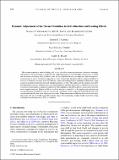| dc.contributor.author | Vinogradova, Nadya T. | |
| dc.contributor.author | Ponte, Rui M. | |
| dc.contributor.author | Quinn, Katherine J. | |
| dc.contributor.author | Tamisiea, Mark E. | |
| dc.contributor.author | Campin, Jean-Michel | |
| dc.contributor.author | Davis, James L. | |
| dc.date.accessioned | 2015-09-08T15:35:55Z | |
| dc.date.available | 2015-09-08T15:35:55Z | |
| dc.date.issued | 2015-03 | |
| dc.date.submitted | 2014-12 | |
| dc.identifier.issn | 0022-3670 | |
| dc.identifier.issn | 1520-0485 | |
| dc.identifier.uri | http://hdl.handle.net/1721.1/98389 | |
| dc.description.abstract | The oceanic response to surface loading, such as that related to atmospheric pressure, freshwater exchange, and changes in the gravity field, is essential to our understanding of sea level variability. In particular, so-called self-attraction and loading (SAL) effects caused by the redistribution of mass within the land–atmosphere–ocean system can have a measurable impact on sea level. In this study, the nature of SAL-induced variability in sea level is examined in terms of its equilibrium (static) and nonequilibrium (dynamic) components, using a general circulation model that implicitly includes the physics of SAL. The additional SAL forcing is derived by decomposing ocean mass anomalies into spherical harmonics and then applying Love numbers to infer associated crustal displacements and gravitational shifts. This implementation of SAL physics incurs only a relatively small computational cost. Effects of SAL on sea level amount to about 10% of the applied surface loading on average but depend strongly on location. The dynamic component exhibits large-scale basinwide patterns, with considerable contributions from subweekly time scales. Departures from equilibrium decrease toward longer time scales but are not totally negligible in many places. Ocean modeling studies should benefit from using a dynamical implementation of SAL as used here. | en_US |
| dc.description.sponsorship | United States. National Aeronautics and Space Administration (Interdisciplinary Science Program Grant NNX11AC14G) | en_US |
| dc.description.sponsorship | National Science Foundation (U.S.) (Grant OCE-0961507) | en_US |
| dc.description.sponsorship | United States. National Aeronautics and Space Administration (Sea Level Change Team Project Grant NNX14AP33G) | en_US |
| dc.language.iso | en_US | |
| dc.publisher | American Meteorological Society | en_US |
| dc.relation.isversionof | http://dx.doi.org/10.1175/jpo-d-14-0150.1 | en_US |
| dc.rights | Article is made available in accordance with the publisher's policy and may be subject to US copyright law. Please refer to the publisher's site for terms of use. | en_US |
| dc.source | American Meteorological Society | en_US |
| dc.title | Dynamic Adjustment of the Ocean Circulation to Self-Attraction and Loading Effects | en_US |
| dc.type | Article | en_US |
| dc.identifier.citation | Vinogradova, Nadya T., Rui M. Ponte, Katherine J. Quinn, Mark E. Tamisiea, Jean-Michel Campin, and James L. Davis. “Dynamic Adjustment of the Ocean Circulation to Self-Attraction and Loading Effects.” Journal of Physical Oceanography 45, no. 3 (March 2015): 678–689. © 2015 American Meteorological Society | en_US |
| dc.contributor.department | Massachusetts Institute of Technology. Department of Earth, Atmospheric, and Planetary Sciences | en_US |
| dc.contributor.mitauthor | Campin, Jean-Michel | en_US |
| dc.relation.journal | Journal of Physical Oceanography | en_US |
| dc.eprint.version | Final published version | en_US |
| dc.type.uri | http://purl.org/eprint/type/JournalArticle | en_US |
| eprint.status | http://purl.org/eprint/status/PeerReviewed | en_US |
| dspace.orderedauthors | Vinogradova, Nadya T.; Ponte, Rui M.; Quinn, Katherine J.; Tamisiea, Mark E.; Campin, Jean-Michel; Davis, James L. | en_US |
| mit.license | PUBLISHER_POLICY | en_US |
| mit.metadata.status | Complete | |
